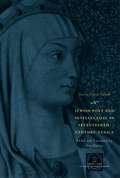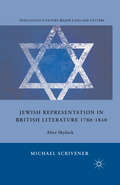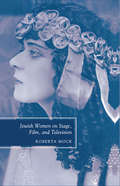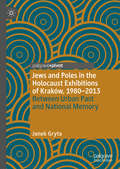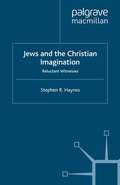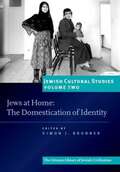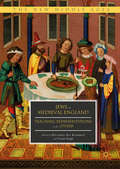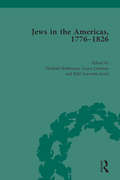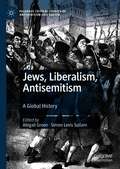- Table View
- List View
Jewish Poet and Intellectual in Seventeenth-Century Venice: The Works of Sarra Copia Sulam in Verse and Prose Along with Writings of Her Contemporaries in Her Praise, Condemnation, or Defense (The Other Voice in Early Modern Europe)
by Sarra Copia SulamThe first Jewish woman to leave her mark as a writer and intellectual, Sarra Copia Sulam (1600?–41) was doubly tainted in the eyes of early modern society by her religion and her gender. This remarkable woman, who until now has been relatively neglected by modern scholarship, was a unique figure in Italian cultural life, opening her home, in the Venetian ghetto, to Jews and Christians alike as a literary salon. For this bilingual edition, Don Harrán has collected all of Sulam’s previously scattered writings—letters, sonnets, a Manifesto—into a single volume. Harrán has also assembled all extant correspondence and poetry that was addressed to Sulam, as well as all known contemporary references to her, making them available to Anglophone readers for the first time. Featuring rich biographical and historical notes that place Sulam in her cultural context, this volume will provide readers with insight into the thought and creativity of a woman who dared to express herself in the male-dominated, overwhelmingly Catholic Venice of her time.
Jewish Poet and Intellectual in Seventeenth-Century Venice: The Works of Sarra Copia Sulam in Verse and Prose Along with Writings of Her Contemporaries in Her Praise, Condemnation, or Defense (The Other Voice in Early Modern Europe)
by Sarra Copia SulamThe first Jewish woman to leave her mark as a writer and intellectual, Sarra Copia Sulam (1600?–41) was doubly tainted in the eyes of early modern society by her religion and her gender. This remarkable woman, who until now has been relatively neglected by modern scholarship, was a unique figure in Italian cultural life, opening her home, in the Venetian ghetto, to Jews and Christians alike as a literary salon. For this bilingual edition, Don Harrán has collected all of Sulam’s previously scattered writings—letters, sonnets, a Manifesto—into a single volume. Harrán has also assembled all extant correspondence and poetry that was addressed to Sulam, as well as all known contemporary references to her, making them available to Anglophone readers for the first time. Featuring rich biographical and historical notes that place Sulam in her cultural context, this volume will provide readers with insight into the thought and creativity of a woman who dared to express herself in the male-dominated, overwhelmingly Catholic Venice of her time.
The Jewish Pope: Myth, Diaspora and Yiddish Literature
by Joseph Sherman"To what extent do Yiddish language and literature derive from the dominant values of mainstream European culture? How far did this culture shape the self-perception of Yiddish-speaking Jews of Central and Eastern Europe? How far did the ambivalent, antagonistic attitude adopted towards Jews over many centuries in Christian Europe shape modern Jewish identity and culture? Sherman deals with such questions in his close examination of the recurring treatment of the myth of the Jewish Pope in four Yiddish literary texts dating from between 1602 and 1943. The roots of this myth - that one day a Jewish apostate might come to rule the world as Pope - lie deep in the Biblical story of the assimilation of Joseph (Genesis 37-50), from which it branches out into numerous Messianic fantasies informing Jewish existence through two thousand years of exile. Concerned with broader questions of cultural identity, this study should be of interest to a general readership."
The Jewish Pope: Myth, Diaspora and Yiddish Literature
by Joseph Sherman"To what extent do Yiddish language and literature derive from the dominant values of mainstream European culture? How far did this culture shape the self-perception of Yiddish-speaking Jews of Central and Eastern Europe? How far did the ambivalent, antagonistic attitude adopted towards Jews over many centuries in Christian Europe shape modern Jewish identity and culture? Sherman deals with such questions in his close examination of the recurring treatment of the myth of the Jewish Pope in four Yiddish literary texts dating from between 1602 and 1943. The roots of this myth - that one day a Jewish apostate might come to rule the world as Pope - lie deep in the Biblical story of the assimilation of Joseph (Genesis 37-50), from which it branches out into numerous Messianic fantasies informing Jewish existence through two thousand years of exile. Concerned with broader questions of cultural identity, this study should be of interest to a general readership."
Jewish Primitivism (Stanford Studies in Jewish History and Culture)
by Samuel J. SpinnerAround the beginning of the twentieth century, Jewish writers and artists across Europe began depicting fellow Jews as savages or "primitive" tribesmen. Primitivism—the European appreciation of and fascination with so-called "primitive," non-Western peoples who were also subjugated and denigrated—was a powerful artistic critique of the modern world and was adopted by Jewish writers and artists to explore the urgent questions surrounding their own identity and status in Europe as insiders and outsiders. Jewish primitivism found expression in a variety of forms in Yiddish, Hebrew, and German literature, photography, and graphic art, including in the work of figures such as Franz Kafka, Y.L. Peretz, S. An-sky, Uri Zvi Greenberg, Else Lasker-Schüler, and Moï Ver. In Jewish Primitivism, Samuel J. Spinner argues that these and other Jewish modernists developed a distinct primitivist aesthetic that, by locating the savage present within Europe, challenged the idea of the threatening savage other from outside Europe on which much primitivism relied: in Jewish primitivism, the savage is already there. This book offers a new assessment of modern Jewish art and literature and shows how Jewish primitivism troubles the boundary between observer and observed, cultured and "primitive," colonizer and colonized.
Jewish Representation in British Literature 1780-1840: After Shylock (Nineteenth-Century Major Lives and Letters)
by M. ScrivenerDescribing Jewish representation by Jews and Gentiles in the British Romantic era from the Old Bailey courtroom and popular songs to novels, poetry, and political pamphlets, Scrivener integrates popular culture with belletristic writing to explore the wildly varying treatments of stereotypical Jewish figures.
The Jewish White Slave Trade and the Untold Story of Raquel Liberman
by Nora GlickmanDescribes the prostitution industry form Poland to Argentina from the 1880s to the 1930s. The text follows the life and career of Raquel Liberman, a Polish Jewish prostitute and victim of the white slave trade.
The Jewish White Slave Trade and the Untold Story of Raquel Liberman
by Nora GlickmanDescribes the prostitution industry form Poland to Argentina from the 1880s to the 1930s. The text follows the life and career of Raquel Liberman, a Polish Jewish prostitute and victim of the white slave trade.
Jewish Women on Stage, Film, and Television
by R. MockThis book exposes and traces a previously unrecognized performance tradition of extraordinary Jewish women in the Diaspora, from Rachel and Sarah Bernhardt in Nineteenth Century France to Roseanne and Sandra Bernhard in late Twentieth Century America.
Jewish Writers/Irish Writers: Selected Essays on the Love of Words
by Maurice Wohlgelernter"These essays on representative Jewish and Irish writers are true to the form's definition as an attempt or experiment rather than a credo. Wohlgelernter defines the author's ""excited imagination"" by thoroughgoing analysis of the work's constituent parts. He gives particular emphasis to the author's own words and expressions, those verbal inventions that linger in the mind long after the act of reading or criticism. He finds a passionate love of words and language forging a powerful link between Jewish and Irish literature, rooted as they are in similar historical experience. Both literatures engage the human struggle with life and death, virtue and weakness, success and failure, dreams and nightmares, all under the constant surveillance of tradition.Wohlgelernter divides his book into four general categories: the Holocaust, Jewish-American writers, Irish writers, and memoirs and autobiography. His chapters on Holocaust literature engage a range of literary perspectives that combine memoir, journalism, fiction, and philosophical reflection in the writings of Ladislas Fuks, Lucy Dawidowicz, Sabine Reichel, and Primo Levi. Chapters on postwar Jewish writers including Saul Bellow, Bernard Malamud, and Philip Roth explore the ambivalences of assimilation with its encroachments of a provincial past and dissatisfactions with mainstream culture. Wohlgelernter notes how all yoke street raciness and high cultural mandarin in a distinctive contribution to American prose style. A similar richness of language and preoccupation with the political and cultural claims of the past characterize the chapters on the great short story writer Frank O'Connor, the playwright Brendan Behan, and the Irish-American journalist and novelist Pete Hamill.The last decades of the twentieth century have seen a prolific outpouring of autobiographical writing, and in the concluding section of the book the author treats representative examples that amplify or reflect on the personal an"
Jewish Writers/Irish Writers: Selected Essays on the Love of Words
by Maurice Wohlgelernter"These essays on representative Jewish and Irish writers are true to the form's definition as an attempt or experiment rather than a credo. Wohlgelernter defines the author's ""excited imagination"" by thoroughgoing analysis of the work's constituent parts. He gives particular emphasis to the author's own words and expressions, those verbal inventions that linger in the mind long after the act of reading or criticism. He finds a passionate love of words and language forging a powerful link between Jewish and Irish literature, rooted as they are in similar historical experience. Both literatures engage the human struggle with life and death, virtue and weakness, success and failure, dreams and nightmares, all under the constant surveillance of tradition.Wohlgelernter divides his book into four general categories: the Holocaust, Jewish-American writers, Irish writers, and memoirs and autobiography. His chapters on Holocaust literature engage a range of literary perspectives that combine memoir, journalism, fiction, and philosophical reflection in the writings of Ladislas Fuks, Lucy Dawidowicz, Sabine Reichel, and Primo Levi. Chapters on postwar Jewish writers including Saul Bellow, Bernard Malamud, and Philip Roth explore the ambivalences of assimilation with its encroachments of a provincial past and dissatisfactions with mainstream culture. Wohlgelernter notes how all yoke street raciness and high cultural mandarin in a distinctive contribution to American prose style. A similar richness of language and preoccupation with the political and cultural claims of the past characterize the chapters on the great short story writer Frank O'Connor, the playwright Brendan Behan, and the Irish-American journalist and novelist Pete Hamill.The last decades of the twentieth century have seen a prolific outpouring of autobiographical writing, and in the concluding section of the book the author treats representative examples that amplify or reflect on the personal an"
Jewish Writers of Latin America: A Dictionary
by Darrell B. LockhartFirst published in 1997. Routledge is an imprint of Taylor & Francis, an informa company.
Jewish Writers of Latin America: A Dictionary (Latin American Studies #Vol. 9)
by Darrell B. LockhartFirst published in 1997. Routledge is an imprint of Taylor & Francis, an informa company.
The Jews and British Romanticism: Volume 2
by S. SpectorExpanding the perspective initiated by British Romanticism and the Jews: History, Culture, Literature (0-312-29522-7), this volume explores more deeply the complexities inherent in the relationship between the British and Jewish cultures as initiated in the Romantic Period in England, though extending to the present in the Middle East.
Jews and Christians in Thirteenth-Century France (The New Middle Ages)
by Elisheva Baumgarten Judah D. GalinskyA period of great change for Europe, the thirteenth-century was a time of both animosity and intimacy for Jewish and Christian communities. In this wide-ranging collection, scholars discuss the changing paradigms in the research and history of Jews and Christians in medieval Europe, discussing law, scholarly pursuits, art, culture, and poetry.
Jews and Poles in the Holocaust Exhibitions of Kraków, 1980–2013: Between Urban Past and National Memory
by Janek GrytaThis book offers a unique approach to memory studies by focusing on local memory work conducted across the divide of the fall of Communism, whereas other histories have consistently used 1989 as a watershed moment. By examining the ways in which the Holocaust has been exhibited in Kraków, it investigates the impact local memory work has had on Polish collective memory and problematizes the importance of the fall of Communism for memory work. Using the Polish case study, it contributes to international debates on the nature of urban memory. It brings to the fore the role of mid-ranking governmental and municipal activists for local remembrance, investigates the relationship between the form and the content of the exhibitions, and highlights the importance of authenticity and emotional evocations for Holocaust remembrance. In particular, it focuses on the emergence of cosmopolitan memory of the Holocaust, a process with local, Kraków, sources.
Jews and the Christian Imagination: Reluctant Witnesses (Studies in Literature and Religion)
by S. HaynesReluctant Witnesses: Jews and the Christian Imagination is an analysis of the ancient Christian myth that casts Jews as a 'witness-people', and this myth's presence in contemporary religious discourse. It treats diverse products of the Christian imagination, including systematic theology, works of fiction, and popular writings on biblical prophecy. The book demonstrates that the witness-people myth, which was first articulated by Augustine and which determined official attitudes towards Jews in medieval Christendom, remains a powerful force in the Christian imagination.
Jews at Home: The Domestication of Identity (Jewish Cultural Studies #2)
by Simon J. BronnerFor a Jew, describing a place as 'home' conveys connotations of heritage as well as of residence. Additionally, feeling 'at home' suggests a sense of comfort in one's social surroundings. The questions at the heart of this volume are: what things make a home 'Jewish', materially and emotionally, and what is it that makes Jews feel 'at home' in their environment? The material dimensions are explored through a study of the symbolic and ritual objects that convey Jewishness and a consideration of other items that may be used to express Jewish identity in the home-something that the introduction identifies as 'living-room Judaism'. The discussion is geographically and ethnically wide-ranging, and the transformation of meaning attached to different objects in different environments is contextualized, as, for example, in Shalom Sabar's study of {h.}amsa amulets in Morocco and Israel. For diasporic Jewish culture, the question of feeling at home is an emotional issue that frequently emerges in literature, folklore, and the visual and performing arts. The phrase 'at-homeness in exile' aptly expresses the tension between the different heritages with which Jews identify, including that between the biblical promised land and the cultural locations from which Jewish migration emanated. The essays in this volume take a closer look at the way in which ideas about feeling at home as a Jew are expressed in literature originating in Brazil, Argentina, and the United States, and also at the political ramifications of these emotions. The question is further explored in a series of exchanges on the future of Jews feeling 'at home' in Australia, Germany, Israel, and the United States. Jews at Home is the first book to examine the theme of the Jewish home materially and emotionally from a variety of disciplinary perspectives, including literature, history, anthropology, sociology, psychology, art history, and folk and popular culture. The essays in the collection use the theme of home and the concept of domestication to revise understanding of the lived (and built) past, and to open new analytical possibilities for the future. Its discussion of domestic culture and its relevance to Jewish identity is one with which readers should feel right at home.
The Jew's Body
by Sander GilmanDrawing on a wealth of medical and historical materials, Sander Gilman sketches details of the anti-Semitic rhetoric about the Jewish body and mind, including medical and popular depictions of the Jewish voice, feet, and nose. Case studies illustrate how Jews have responded to such public misconceptions as the myth of the cloven foot and Jewish flat-footedness, the proposed link between the Jewish mind and hysteria, and the Victorians' irrational connection between Jews and prostitutes. Gilman is especially concerned with the role of psychoanalysis in the construction of anti-Semitism, examining Freud's attitude towards his own Jewishness and its effect on his theories, as well as the supposed "objectiveness" of psychiatrists and social scientists.
The Jew's Body
by Sander GilmanDrawing on a wealth of medical and historical materials, Sander Gilman sketches details of the anti-Semitic rhetoric about the Jewish body and mind, including medical and popular depictions of the Jewish voice, feet, and nose. Case studies illustrate how Jews have responded to such public misconceptions as the myth of the cloven foot and Jewish flat-footedness, the proposed link between the Jewish mind and hysteria, and the Victorians' irrational connection between Jews and prostitutes. Gilman is especially concerned with the role of psychoanalysis in the construction of anti-Semitism, examining Freud's attitude towards his own Jewishness and its effect on his theories, as well as the supposed "objectiveness" of psychiatrists and social scientists.
Jews in Medieval England: Teaching Representations of the Other
by Miriamne Ara Krummel Tison PughThis volume examines the teaching of Jewishness within the context of medieval England. It covers a wide array of academic disciplines and addresses a multitude of primary sources, including medieval English manuscripts, law codes, philosophy, art, and literature, in explicating how the Jew-as-Other was formed. Chapters are devoted to the teaching of the complexities of medieval Jewish experiences in the modern classroom. Jews in Medieval England: Teaching Representations of the Other also grounds medieval conceptions of the Other within the contemporary world where we continue to confront the problematic attitudes directed toward alleged social outcasts.
Jews in Medieval England: Teaching Representations of the Other
by Miriamne Ara Krummel Tison PughThis volume examines the teaching of Jewishness within the context of medieval England. It covers a wide array of academic disciplines and addresses a multitude of primary sources, including medieval English manuscripts, law codes, philosophy, art, and literature, in explicating how the Jew-as-Other was formed. Chapters are devoted to the teaching of the complexities of medieval Jewish experiences in the modern classroom. Jews in Medieval England: Teaching Representations of the Other also grounds medieval conceptions of the Other within the contemporary world where we continue to confront the problematic attitudes directed toward alleged social outcasts.
Jews in the Americas, 1776-1826 (Routledge Historical Resources)
by Michael Hoberman Laura Leibman Hilit Surowitz-IsraelThe period between 1776-1826 signalled a major change in how Jewish identity was understood both by Jews and non-Jews throughout the Americas. Jews in the Americas, 1776-1826 brings this world of change to life by uniting important out-of-print primary sources on early American Jewish life with rare archival materials that can currently be found only in special collections in Europe, England, the United States, and the Caribbean.
Jews in the Americas, 1776-1826 (Routledge Historical Resources)
by Michael Hoberman Laura Leibman Hilit Surowitz-IsraelThe period between 1776-1826 signalled a major change in how Jewish identity was understood both by Jews and non-Jews throughout the Americas. Jews in the Americas, 1776-1826 brings this world of change to life by uniting important out-of-print primary sources on early American Jewish life with rare archival materials that can currently be found only in special collections in Europe, England, the United States, and the Caribbean.
Jews, Liberalism, Antisemitism: A Global History (Palgrave Critical Studies of Antisemitism and Racism)
by Abigail Green Simon Levis Sullam“This is a timely contribution to some of the most pressing debates facing scholars of Jewish Studies today. It forces us to re-think standard approaches to both antisemitism and liberalism. Its geographic scope offers a model for how scholars can “provincialize” Europe and engage in a transnational approach to Jewish history. The book crackles with intellectual energy; it is truly a pleasure to read.”- Jessica M. Marglin, University of Southern California, USAGreen and Levis Sullam have assembled a collection of original, and provocative essays that, in illuminating the historic relationship between Jews and liberalism, transform our understanding of liberalism itself. - Derek Penslar, Harvard University, USA“This book offers a strikingly new account of Liberalism’s relationship to Jews. Previous scholarship stressed that Liberalism had to overcome its abivalence in order to achieve a principled stand on granting Jews rights and equality. This volume asserts, through multiple examples, that Liberalism excluded many groups, including Jews, so that the exclusion of Jews was indeed integral to Liberalism and constitutive for it. This is an important volume, with a challenging argument for the present moment.”- David Sorkin, Yale University, USAThe emancipatory promise of liberalism – and its exclusionary qualities – shaped the fate of Jews in many parts of the world during the age of empire. Yet historians have mostly understood the relationship between Jews, liberalism and antisemitism as a European story, defined by the collapse of liberalism and the Holocaust. This volume challenges that perspective by taking a global approach. It takes account of recent historical work that explores issues of race, discrimination and hybrid identities in colonial and postcolonial settings, but which has done so without taking much account of Jews. Individual essays explore how liberalism, citizenship, nationality, gender, religion, race functioned differently in European Jewish heartlands, in the Mediterranean peripheries of Spain and the Ottoman empire, and in the North American Atlantic world.
